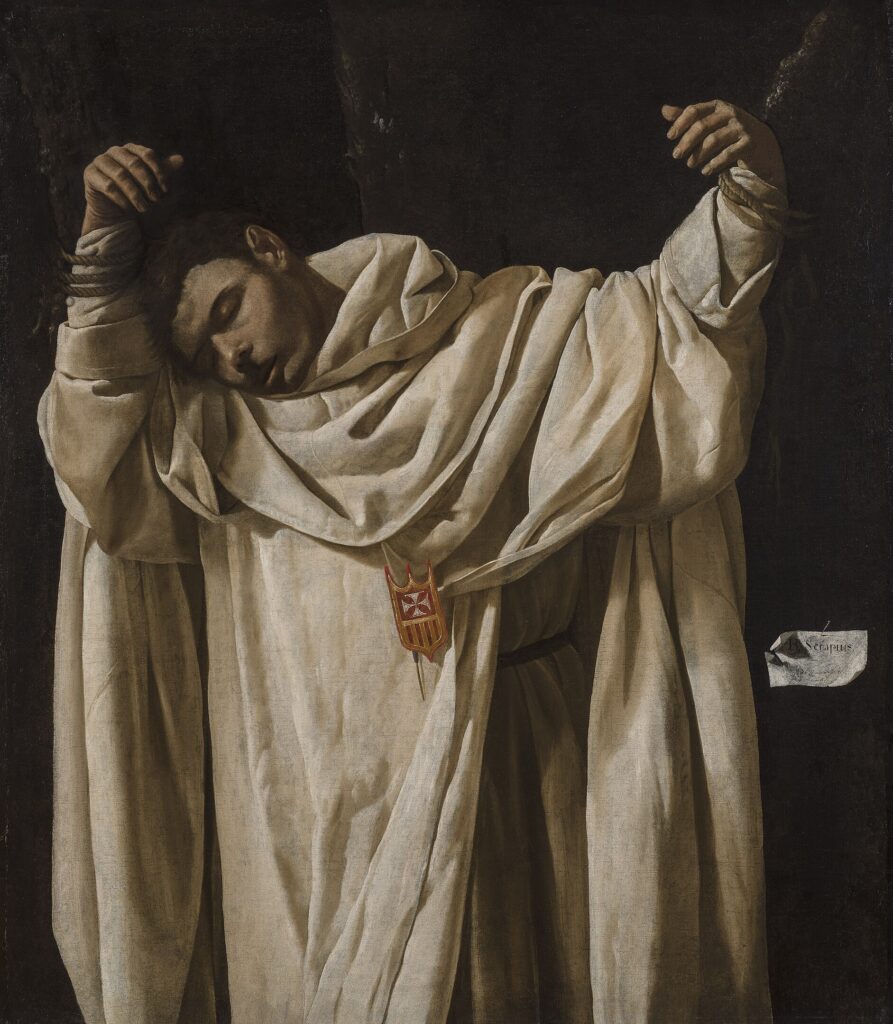
“St Serapion”, Francisco de Zurbarán, 1628, Wadsworth Atheneum, Hartfort.
A strong light reveals a man suspended in darkness. The man is dead. He hangs by his wrists which have been tied to wooden poles. The white habit of a friar is now his shroud. The habit is a “symphony of light and shadow” having been painted with masterful realism. You might even believe you could touch it. But there is no depth, the dead man is very close to the viewer. Two small elements in the painting tell of who he was. On his habit, and positioned at the exact centre of the image, is the distinctive insignia of the Mercedarian friars. Like the Dominicans they were founded about 800 years ago. Their main work was to ransom Christians taken captive by Muslim pirates. In addition to the usual three vows of religious life, each friar took a fourth which was to be ready to offer himself as the ransom for a captive. The Order continues today in Spain, Italy, the United States and elsewhere with a major focus on prison ministry. The other telling element is the small piece of white paper which is shown as if it were pinned to the canvas. On it Francisco de Zurbarán has put his own name and that of St Serapion (1179 – 1240), who was the first Mercedarian friar to suffer martyrdom. Centuries later, the friars in Seville commissioned this painting for the chapel where friars were brought after death and prayers were offered for them by their brothers. Remarkably, Zurbarán does not show Serapion’s broken and dismembered body. But then each friar knew only too well the gruesome account of this martyrdom. Each knew where the fourth vow might take him. Many commentators have seen a suggestion of the terrible violence which this saint underwent in the position of his head and in the tousled arrangement of the white cloth, which with its complex folds, is arranged by Zurbarán both to conceal and reveal the body beneath. Generally, Zurbarán in his choice of subject matter, preferred stillness to action. So many of his works have this oddly arresting stillness which becomes, the more you look , profound silence. Serapion died in 1240 at the hands of pirates, but the accounts vary as to where he died; Marseilles, Algiers, even Scotland! There is nothing in this picture to suggest either time or place. The small scrap of paper looks as if it were real and yet it is not. It, like the martyr, exists only within the picture plane, in a place which is nowhere; a place of deep darkness yet a place where there is also this astonishing light; a light strong enough to overcome the deep enshrouding darkness. in this work Zurbarán’s darks are death and the light tones the light of resurrection. Faith in the Risen Jesus is there in every brush stroke, as white pigment is exquisitely laid against the darkest of grounds. Hear again the second reading for today. “We see Jesus, who for a little while was made lower than the angels, crowned with glory and honour because of the suffering of death, so that by the grace of God he might taste death for every one.”
The Catholic Chaplaincy serves the students and staff of the University of Edinburgh, Edinburgh Napier University and Queen Margaret University.
The Catholic Chaplaincy is also a parish of the Archdiocese of St Andrews and Edinburgh (the Parish of St Albert the Great) and all Catholic students and staff are automatically members of this parish.